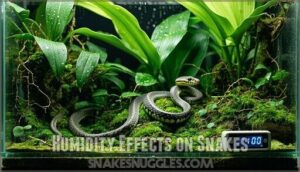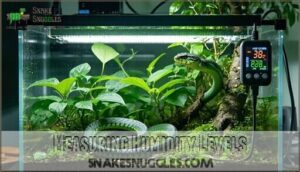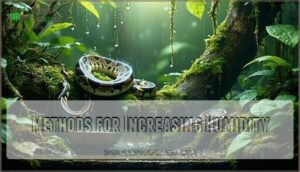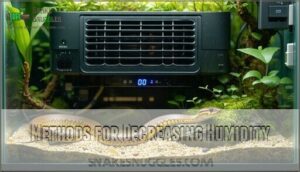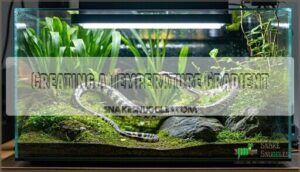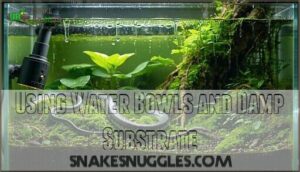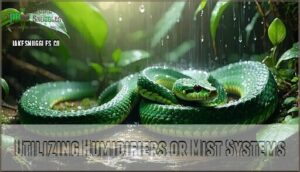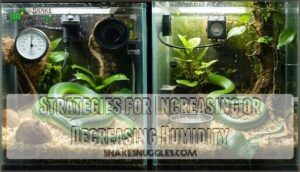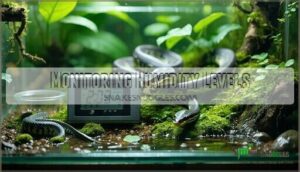This site is supported by our readers. We may earn a commission, at no cost to you, if you purchase through links.
 You’ll need to match your snake’s humidity levels to its natural habitat.
You’ll need to match your snake’s humidity levels to its natural habitat.
Desert species like corn snakes thrive at 40-50% humidity, while tropical ball pythons need 50-60%, and rainforest species like emerald tree boas require 70-90%.
Incorrect humidity can cause respiratory infections, shedding problems, and dehydration.
You can maintain proper levels using a reliable hygrometer, misting systems, larger water dishes, or substrate adjustments.
Think of humidity like your snake’s climate control system—it’s not just comfort, it’s survival.
The right balance between dry and damp creates the perfect microclimate where your scaled friend will truly flourish.
Table Of Contents
- Key Takeaways
- Snake Humidity Requirements
- Humidity Effects on Snakes
- Maintaining Proper Humidity
- Humidity Management Techniques
- Monitoring Humidity Levels
- Frequently Asked Questions (FAQs)
- Is 80% humidity too high for ball pythons?
- Is 70 humidity too high for a corn snake?
- Is 70% humidity good for ball pythons?
- Do snakes need humidity?
- What is the ideal humidity range for pet snakes?
- What happens if humidity is too low for a snake?
- Do snakes need humidifiers?
- How do I maintain humidity in my snake tank?
- What is a good humidity level for a snake tank?
- What is the ideal temperature range for a ball python’s habitat?
- Conclusion
Key Takeaways
- You’ll need to match your snake’s humidity levels to its natural habitat – desert species thrive at 40-50%, tropical species need 50-60%, and rainforest species require 70-90%.
- Your snake’s humidity directly impacts its health, affecting shedding, respiration, and skin condition – incorrect levels can cause respiratory infections, stuck shed, scale rot, and dehydration.
- You can maintain proper humidity using digital hygrometers for accurate monitoring, misting systems, larger water dishes near heat sources, and moisture-retaining substrates like coconut fiber.
- You should create humidity gradients in your snake’s enclosure rather than uniform conditions, and adjust your approach seasonally to prevent common mistakes like over-misting or poor ventilation.
Snake Humidity Requirements
Snakes rely on specific humidity levels to stay healthy, shed properly, and avoid respiratory or skin issues.
By understanding your snake’s natural habitat and its unique requirements, you can create an environment that keeps it thriving, which is crucial for maintaining the snake’s overall health and ensuring it thrives.
Humidity Levels for Different Species
Snake species thrive within specific humidity levels based on their native habitats.
For balanced snake care, use this guide:
- Desert snakes like Rosy Boas need 20-40% humidity.
- Tropical species, such as Green Tree Pythons, prefer 70-90%.
- Arboreal snakes, like Amazon Tree Boas, require 80-90%.
- Aquatic species often enjoy higher Regional Humidity Needs.
Tailoring reptile humidity guarantees health!
Low Humidity Species
Not all snakes need tropical rainforests in their enclosures—desert snakes, like Corn Snakes or Milk Snakes, thrive with lower humidity levels around 40-50%.
Proper enclosure ventilation keeps the air fresh, preventing Respiratory Issues.
Here’s a quick guide:
| Snake Type | Humidity Level | Common Issues |
|---|---|---|
| Corn Snake | 40-50% | Shedding Problems |
| Milk Snake | 40-60% | Respiratory Issues |
| Desert Rattler | 30-40% | Skin Dryness |
Focus on dry substrate selection and careful humidity control to ensure the well-being of your snakes.
Moderate Humidity Species
For species like corn snakes and milk snakes, proper humidity in their enclosures sits around 40-60%.
This "goldilocks zone" supports smooth shedding and prevents skin issues.
Aim for natural balance—think water bowls or slightly damp substrate.
Overdo it, though, and you’re inviting mold or respiratory problems.
Designing the habitat just right keeps your snake healthy and stress-free.
High Humidity Species
Tropical and semi-aquatic snakes, like Green Tree Pythons and Blood Pythons, thrive with humidity levels between 60-80%.
Their humidity adaptations are key for respiratory health and preventing fungal infections.
To maintain proper snake enclosure humidity, mist the enclosure, use damp substrate, and monitor levels with a hygrometer.
Balanced snake humidity guarantees shedding stays smooth and their environment mimics natural conditions.
Humidity Effects on Snakes
Humidity plays a vital role in your snake’s overall health, affecting everything from hydration to proper shedding.
When humidity levels are too high or low, it can lead to serious problems like respiratory issues or skin infections, so it’s essential to keep conditions just right.
This balance is crucial for maintaining your snake’s health, and humidity levels must be carefully monitored to prevent complications.
Role in Shedding and Hydration
Proper humidity levels directly impact your snake’s ability to maintain healthy ecdysis—aka shedding—and avoid dehydration symptoms.
Without enough humidity, shedding problems arise, leaving bits of old skin behind. A balanced humidity gradient and methods like increasing substrate moisture or misting help.
A reliable hygrometer is essential for monitoring these levels. Think of it as their spa day; happy, hydrated snakes mean easier snake shedding and fewer headaches for you, ensuring a healthy and hydrated environment with proper humidity.
Effect on Snake Respiration
Your snake’s breathing isn’t just about air—it’s about balancing humidity levels. Low humidity can dry out their mucus linings, making snake respiration harder and increasing Pneumonia Risks.
Too much humidity might allow bacteria to cause Respiratory Infections or Breathing Difficulty.
- Keep humidity levels ideal for snake health.
- Avoid sudden Humidity Impact.
- Use hygrometers daily.
- Watch for shedding problems.
- Prioritize clean, ventilated enclosures.
Impact on Skin and Scale Health
Humidity levels directly impact snake health.
Too low, and shedding problems arise, like dysecdysis (stuck skin).
Too high, and risks like scale rot and fungal infections surface.
Skin infections and dehydration effects can snowball without balance.
Think of a snake’s skin as a delicate canvas—it thrives with steady, proper humidity.
| Problem | Cause | Effect | Solution |
|---|---|---|---|
| Shedding Problems | Low humidity | Dysecdysis | Increase misting |
| Scale Rot | Excessive moisture | Skin ulcers, infections | Improve ventilation |
| Dehydration Effects | Dry conditions | Flaky skin, dull scales | Add larger water bowls |
| Fungal Infections | Persistent dampness | Growth of harmful fungi | Guarantee drainage/cleaning |
The solution to these problems involves simple yet effective measures, such as increasing misting, improving ventilation, adding larger water bowls, and guaranteeing drainage/cleaning to prevent dehydration effects.
Maintaining Proper Humidity
You’ll need to keep a close eye on your snake’s humidity levels to guarantee they stay within the safe range for its species.
Using the right tools and techniques, like hygrometers and misting systems, makes it easy to create a comfortable, healthy environment.
Measuring Humidity Levels
To measure humidity levels in your snake’s enclosure accurately, use a quality hygrometer.
Digital options are more precise than analog, offering features like remote monitoring. Calibrate your hygrometer regularly for consistency.
Place it in key spots to check humidity gradients, especially near basking zones and hides. Avoid relying on guesswork—it’s like traveling without a map!
For ideal readings, consider hygrometer product availability.
- **Use a calibrated hygrometer.
- **Monitor humidity gradients.
- **Choose digital for accuracy.
Methods for Increasing Humidity
Boosting snake enclosure humidity can be simple. Try misting systems for consistent moisture, dampen the substrate—like coconut core—for better retention, or add a large water bowl near a heat source.
Introduce plants; they naturally release moisture and spruce up the space. Check out snake misting solutions for humidity control.
Remember, enclosure size affects humidity control—smaller spaces retain moisture better, keeping snake humidity levels just right.
Methods for Decreasing Humidity
If humidity’s too high, tackle it with better enclosure ventilation and airflow optimization.
Open vents, add low-moisture substrate, and clean more frequently to prevent excessive moisture retention.
Dehumidifier types, from portable units to built-ins, work wonders for humidity adjustments.
Remember, even small humidity control tweaks keep your snake comfy—like cracking a window on a stuffy day to make a small humidity change!
Creating a Temperature Gradient
Start by balancing your snake’s temperature gradient—it helps with humidity control too.
A clear gradient guarantees comfort and health.
- Place a heat source like a lamp or mat for a basking spot (90-100°F).
- Keep a cool zone around 75°F.
- Maintain proper enclosure ventilation.
- Adjust basking and cool zones according to species variation, aiding in the right humidity gradient.
A proper gradient is essential for optimal thermoregulation needs, which can be found at optimal thermoregulation needs, and it is crucial for the snake’s overall health and comfort.
Humidity Management Techniques
You can maintain proper humidity in your snake’s enclosure by using tools like water bowls, damp substrate, and misting systems.
Each technique helps you create a stable, healthy environment that mimics their natural habitat.
Using Water Bowls and Damp Substrate
Using a water bowl and damp substrate works wonders for snake tank humidity. Place the bowl near heat sources for better evaporation rates.
Keep substrate saturation levels balanced—too wet invites mold, too dry drops humidity. Good drainage prevents soggy spots.
Mold prevention is key, so monitor regularly. Maintaining appropriate humidity is vital, as extreme swings cause health issues.
Proper water bowl placement and substrate care guarantee your snake’s habitat stays just right.
| Technique | Purpose | Key Tip |
|---|---|---|
| Water Bowl Placement | Boosts evaporation rates | Place near heat source |
| Damp Substrate Use | Maintains humidity levels | Use moisture-retaining types |
| Substrate Drainage | Prevents mold | Add drainage layer |
| Regular Monitoring | Ensures balance | Check daily for dampness |
| Mold Prevention Strategy | Keeps environment healthy | Limit over-saturation |
Utilizing Humidifiers or Mist Systems
In regards to maintaining snake tank humidity, humidifier types like ultrasonic or foggers offer consistent moisture, while automated control in mist systems simplifies upkeep.
Regular maintenance schedules prevent issues, ensuring water quality stays prime.
For added precision, misting snakes directly can help meet humidity requirements.
Proper humidity is vital, as it helps prevent respiratory and skin issues.
Just avoid oversaturating, as too much mist risks surface dampness and mold growth.
Strategies for Increasing or Decreasing Humidity
Beyond automated misting systems, you’ll need various strategies for fine-tuning your snake’s environment.
To increase humidity, try selecting moisture-retaining substrates like coconut fiber, covering part of the enclosure, or adjusting water bowl placement to maximize evaporation.
For decreasing humidity, improve ventilation control by adding air holes or using a small dehumidifier.
Regular hygrometer use guarantees your snake humidity levels remain ideal throughout seasonal changes, which is crucial for maintaining an optimal environment with proper ventilation control.
Monitoring Humidity Levels
You’ll need to consistently monitor humidity levels in your snake’s enclosure using reliable equipment such as digital hygrometers for accurate readings.
Regular checks help you identify and correct issues before they affect your pet’s health, particularly during critical periods like shedding when proper humidity becomes even more essential.
This ensures that you can provide the best environment for your snake, and regular checks are crucial for maintaining its health.
Tools for Monitoring Humidity
Now that you know how to manage humidity, let’s look at how to measure it accurately.
Digital hygrometers offer the most precise humidity measurement for your snake’s enclosure.
While analog hygrometers are budget-friendly, they’re less reliable.
Owners often source reptile care products from online retailers.
For tech-savvy owners, thermometer-hygrometer combos or SensorPush systems provide remote monitoring benefits.
Many modern thermostats include humidity control features, working alongside misting systems for automated environment management.
Signs of Improper Humidity Levels
Watch out for these telltale signs of humidity problems in your snake’s enclosure.
Rough, crispy skin and incomplete sheds indicate too-dry conditions, while crinkled, shiny scales suggest excessive moisture.
Respiratory issues, such as wheezing or bubbling around the nostrils, can develop from low humidity.
Conversely, scale rot and fungal infections often result from high humidity combined with poor ventilation.
Be alert for behavioral changes like increased soaking or abnormal hiding behaviors, which can indicate humidity problems.
Common Mistakes in Humidity Control
New snake owners make critical errors in humidity control that can harm their reptiles.
Using inaccurate hygrometers leads to improper readings, while ventilation problems create dangerously stagnant air.
Ignoring humidity gradients, over-misting enclosures, and choosing the wrong substrate can trigger respiratory infections.
Many enthusiasts mistakenly maintain uniform conditions throughout the enclosure instead of creating natural variations that snakes experience in the wild.
Regular calibration guarantees accurate hygrometer readings to prevent such issues, ensuring a healthy environment for the snakes through proper ventilation problems and respiratory infections awareness.
Tips for Maintaining Proper Humidity
Consistent humidity maintenance requires a balanced approach. Choose moisture-retaining substrates like coconut husk or cypress mulch for your snake’s enclosure.
Implement regular misting schedules based on your specific species’ needs. Install proper ventilation strategies to prevent mold growth while maintaining humidity levels.
Use reliable monitoring tools such as digital hygrometers to track conditions daily. For emergency fixes when humidity drops, quickly mist the enclosure or add damp sphagnum moss to specific areas to achieve proper ventilation.
Frequently Asked Questions (FAQs)
Is 80% humidity too high for ball pythons?
Yes, 80% humidity is too high for ball pythons. Your snake needs 60-70% humidity, with brief increases only during shedding. Excessive moisture can lead to respiratory problems and scale rot.
Is 70 humidity too high for a corn snake?
Yes, 70% humidity is slightly too high for corn snakes.
They thrive, survive, and revive in moderate humidity between 40-50%.
You’ll want to lower it to prevent scale rot and respiratory issues.
Is 70% humidity good for ball pythons?
Ball pythons thrive at humidity levels of 60-70%, making 70% ideal for their tropical needs.
You’ll notice better shedding and respiratory health at this level, but monitor to prevent it climbing higher.
Do snakes need humidity?
Ever wondered why your scaly friend struggles with shedding?
Yes, snakes need humidity to properly shed their skin, maintain respiratory health, and prevent dehydration.
Requirements vary by species, typically ranging from 40-75%.
What is the ideal humidity range for pet snakes?
The ideal humidity for pet snakes varies by species.
You’ll want to maintain 40-50% for corn snakes, 55-75% for boas, and >60% for ball pythons.
A digital hygrometer helps monitor these levels accurately.
What happens if humidity is too low for a snake?
Low humidity causes incomplete shedding, where skin sticks to your snake’s body, causing discomfort and potential health issues.
It’ll also increase risk of respiratory infections and dehydration, which can become life-threatening if not addressed.
Do snakes need humidifiers?
Nearly 70% of reptile health issues stem from improper humidity levels. You don’t necessarily need humidifiers for snakes, but many species benefit from them, especially those requiring humidity levels above 60%.
How do I maintain humidity in my snake tank?
Regulate your snake’s tank humidity by misting daily, using a larger water dish, and adding moisture-retaining substrates like coconut fiber.
You’ll also want to monitor levels with a digital hygrometer for species-specific needs.
What is a good humidity level for a snake tank?
Humidity levels for snake tanks are as essential as water in a desert.
You’ll want 40-60% for corn snakes, 55-75% for boas, and >60% for ball pythons.
Match your specific snake’s natural habitat.
What is the ideal temperature range for a ball python’s habitat?
You’ll want to maintain your ball python’s habitat with a warm side at 88-92°F and a cool side at 78-80°F.
Don’t forget a basking spot of 95-100°F for proper digestion.
Conclusion
Like a skilled gardener tending to different plants, managing snake humidity levels requires attention to specific needs.
By understanding your snake’s natural habitat requirements, consistently monitoring conditions, and making appropriate adjustments, you’ll create an environment where your reptile thrives.
Remember that proper snake humidity levels aren’t just about comfort—they’re essential for health, shedding, and overall wellbeing.
With the right balance and regular monitoring, you’ll enjoy watching your snake flourish in its perfectly humidified home.
- https://youtu.be/GRfJu_FPYW4?si=8eyEpkWsYmOGdg7q
- https://www.reptifiles.com/red-tailed-boa-care/boa-species-subspecies/
- https://www.semanticscholar.org/paper/Does-exposure-to-UVB-light-influence-the-growth-and-Palmer/0014580c213ab41081af864d56ed6bae3332c81d
- http://www.lightyourreptiles.com/arcadia-d3-t-5-22-inch-24-watt-6-forest-uvb/
- https://www.reptilebasics.com/t5-light-fixtures/shadedweller-max/


